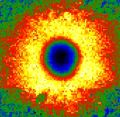Speaker
Description
The silicon-vacancy (SiV) color center is a light-emitting crystallographic point defect with a narrow zero phonon line (ZPL) at 738 nm and a high Debye-Waller factor of 70%. The SiV center can be fabricated in polycrystalline diamond (PCD) thin films by the chemical vapor deposition (CVD) technique. PCD films with SiV centers emerged as promising candidates for applications in sensing, bio-imaging and quantum optics. However, due to the grain structure of PCD thin films, the usage of the zero-emission line (ZPL) of the SiV centers is limited by the defect-related photoluminescence (PL) background stemming from the strain between the individual diamond grains and the presence of non-diamond carbon phases. To suppress the strain and the background PL, we investigated the influence of deposition process parameters, specifically we systematically increased the amount of CH4 from 1 to 15 % to H2 and studied how it influences the structural and PL properties of the grown films. Furthermore, we investigated the influence of the SiV-free diamond barrier layer. The steady-state PL spectra showed that with increasing the amount of CH4, the values of the SiV centers ZPL spectral position slowly decrease towards the monocrystalline reference sample, which shows that the quality of the fabricated PCD is improving. The samples with the highest SiV centers ZPL to PL background ratio were the samples grown with the ratio of CH4 to H2 between 4 and 8%. Lastly, Raman spectroscopy, SEM, and AFM measurements gave us information about the structural changes and their dependence on the amount of CH4 used during the deposition.

